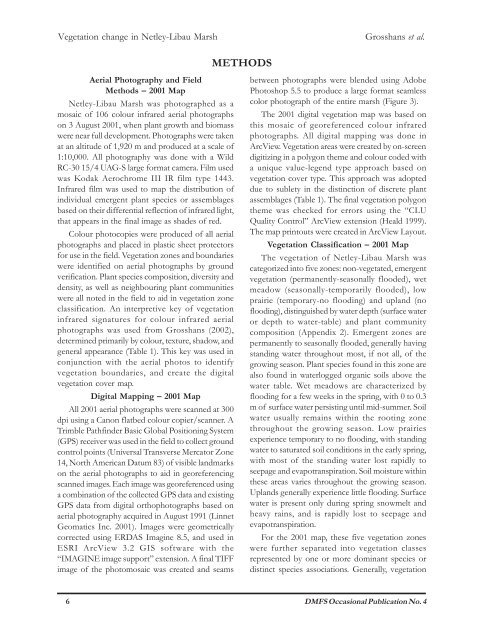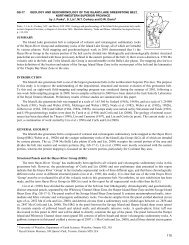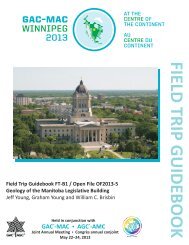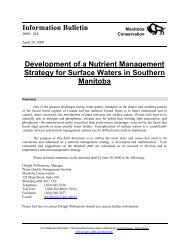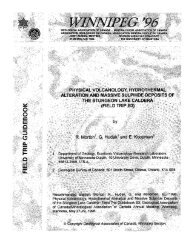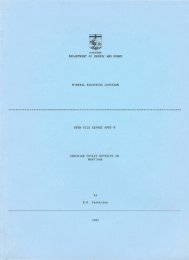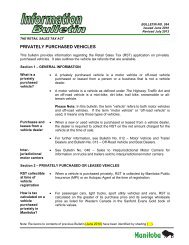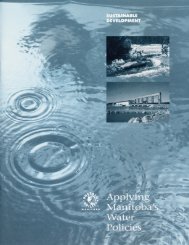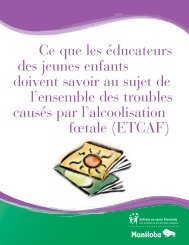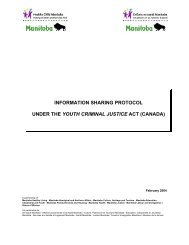Changes in the Emergent Plant Community of Netley-Libau Marsh ...
Changes in the Emergent Plant Community of Netley-Libau Marsh ...
Changes in the Emergent Plant Community of Netley-Libau Marsh ...
You also want an ePaper? Increase the reach of your titles
YUMPU automatically turns print PDFs into web optimized ePapers that Google loves.
Vegetation change <strong>in</strong> <strong>Netley</strong>-<strong>Libau</strong> <strong>Marsh</strong><br />
Grosshans et al.<br />
METHODS<br />
Aerial Photography and Field<br />
Methods – 2001 Map<br />
<strong>Netley</strong>-<strong>Libau</strong> <strong>Marsh</strong> was photographed as a<br />
mosaic <strong>of</strong> 106 colour <strong>in</strong>frared aerial photographs<br />
on 3 August 2001, when plant growth and biomass<br />
were near full development. Photographs were taken<br />
at an altitude <strong>of</strong> 1,920 m and produced at a scale <strong>of</strong><br />
1:10,000. All photography was done with a Wild<br />
RC-30 15/4 UAG-S large format camera. Film used<br />
was Kodak Aerochrome III IR film type 1443.<br />
Infrared film was used to map <strong>the</strong> distribution <strong>of</strong><br />
<strong>in</strong>dividual emergent plant species or assemblages<br />
based on <strong>the</strong>ir differential reflection <strong>of</strong> <strong>in</strong>frared light,<br />
that appears <strong>in</strong> <strong>the</strong> f<strong>in</strong>al image as shades <strong>of</strong> red.<br />
Colour photocopies were produced <strong>of</strong> all aerial<br />
photographs and placed <strong>in</strong> plastic sheet protectors<br />
for use <strong>in</strong> <strong>the</strong> field. Vegetation zones and boundaries<br />
were identified on aerial photographs by ground<br />
verification. <strong>Plant</strong> species composition, diversity and<br />
density, as well as neighbour<strong>in</strong>g plant communities<br />
were all noted <strong>in</strong> <strong>the</strong> field to aid <strong>in</strong> vegetation zone<br />
classification. An <strong>in</strong>terpretive key <strong>of</strong> vegetation<br />
<strong>in</strong>frared signatures for colour <strong>in</strong>frared aerial<br />
photographs was used from Grosshans (2002),<br />
determ<strong>in</strong>ed primarily by colour, texture, shadow, and<br />
general appearance (Table 1). This key was used <strong>in</strong><br />
conjunction with <strong>the</strong> aerial photos to identify<br />
vegetation boundaries, and create <strong>the</strong> digital<br />
vegetation cover map.<br />
Digital Mapp<strong>in</strong>g – 2001 Map<br />
All 2001 aerial photographs were scanned at 300<br />
dpi us<strong>in</strong>g a Canon flatbed colour copier/scanner. A<br />
Trimble Pathf<strong>in</strong>der Basic Global Position<strong>in</strong>g System<br />
(GPS) receiver was used <strong>in</strong> <strong>the</strong> field to collect ground<br />
control po<strong>in</strong>ts (Universal Transverse Mercator Zone<br />
14, North American Datum 83) <strong>of</strong> visible landmarks<br />
on <strong>the</strong> aerial photographs to aid <strong>in</strong> georeferenc<strong>in</strong>g<br />
scanned images. Each image was georeferenced us<strong>in</strong>g<br />
a comb<strong>in</strong>ation <strong>of</strong> <strong>the</strong> collected GPS data and exist<strong>in</strong>g<br />
GPS data from digital orthophotographs based on<br />
aerial photography acquired <strong>in</strong> August 1991 (L<strong>in</strong>net<br />
Geomatics Inc. 2001). Images were geometrically<br />
corrected us<strong>in</strong>g ERDAS Imag<strong>in</strong>e 8.5, and used <strong>in</strong><br />
ESRI ArcView 3.2 GIS s<strong>of</strong>tware with <strong>the</strong><br />
“IMAGINE image support” extension. A f<strong>in</strong>al TIFF<br />
image <strong>of</strong> <strong>the</strong> photomosaic was created and seams<br />
between photographs were blended us<strong>in</strong>g Adobe<br />
Photoshop 5.5 to produce a large format seamless<br />
color photograph <strong>of</strong> <strong>the</strong> entire marsh (Figure 3).<br />
The 2001 digital vegetation map was based on<br />
this mosaic <strong>of</strong> georeferenced colour <strong>in</strong>frared<br />
photographs. All digital mapp<strong>in</strong>g was done <strong>in</strong><br />
ArcView. Vegetation areas were created by on-screen<br />
digitiz<strong>in</strong>g <strong>in</strong> a polygon <strong>the</strong>me and colour coded with<br />
a unique value-legend type approach based on<br />
vegetation cover type. This approach was adopted<br />
due to sublety <strong>in</strong> <strong>the</strong> dist<strong>in</strong>ction <strong>of</strong> discrete plant<br />
assemblages (Table 1). The f<strong>in</strong>al vegetation polygon<br />
<strong>the</strong>me was checked for errors us<strong>in</strong>g <strong>the</strong> “CLU<br />
Quality Control” ArcView extension (Heald 1999).<br />
The map pr<strong>in</strong>touts were created <strong>in</strong> ArcView Layout.<br />
Vegetation Classification – 2001 Map<br />
The vegetation <strong>of</strong> <strong>Netley</strong>-<strong>Libau</strong> <strong>Marsh</strong> was<br />
categorized <strong>in</strong>to five zones: non-vegetated, emergent<br />
vegetation (permanently-seasonally flooded), wet<br />
meadow (seasonally-temporarily flooded), low<br />
prairie (temporary-no flood<strong>in</strong>g) and upland (no<br />
flood<strong>in</strong>g), dist<strong>in</strong>guished by water depth (surface water<br />
or depth to water-table) and plant community<br />
composition (Appendix 2). <strong>Emergent</strong> zones are<br />
permanently to seasonally flooded, generally hav<strong>in</strong>g<br />
stand<strong>in</strong>g water throughout most, if not all, <strong>of</strong> <strong>the</strong><br />
grow<strong>in</strong>g season. <strong>Plant</strong> species found <strong>in</strong> this zone are<br />
also found <strong>in</strong> waterlogged organic soils above <strong>the</strong><br />
water table. Wet meadows are characterized by<br />
flood<strong>in</strong>g for a few weeks <strong>in</strong> <strong>the</strong> spr<strong>in</strong>g, with 0 to 0.3<br />
m <strong>of</strong> surface water persist<strong>in</strong>g until mid-summer. Soil<br />
water usually rema<strong>in</strong>s with<strong>in</strong> <strong>the</strong> root<strong>in</strong>g zone<br />
throughout <strong>the</strong> grow<strong>in</strong>g season. Low prairies<br />
experience temporary to no flood<strong>in</strong>g, with stand<strong>in</strong>g<br />
water to saturated soil conditions <strong>in</strong> <strong>the</strong> early spr<strong>in</strong>g,<br />
with most <strong>of</strong> <strong>the</strong> stand<strong>in</strong>g water lost rapidly to<br />
seepage and evapotranspiration. Soil moisture with<strong>in</strong><br />
<strong>the</strong>se areas varies throughout <strong>the</strong> grow<strong>in</strong>g season.<br />
Uplands generally experience little flood<strong>in</strong>g. Surface<br />
water is present only dur<strong>in</strong>g spr<strong>in</strong>g snowmelt and<br />
heavy ra<strong>in</strong>s, and is rapidly lost to seepage and<br />
evapotranspiration.<br />
For <strong>the</strong> 2001 map, <strong>the</strong>se five vegetation zones<br />
were fur<strong>the</strong>r separated <strong>in</strong>to vegetation classes<br />
represented by one or more dom<strong>in</strong>ant species or<br />
dist<strong>in</strong>ct species associations. Generally, vegetation<br />
6 DMFS Occasional Publication No. 4


